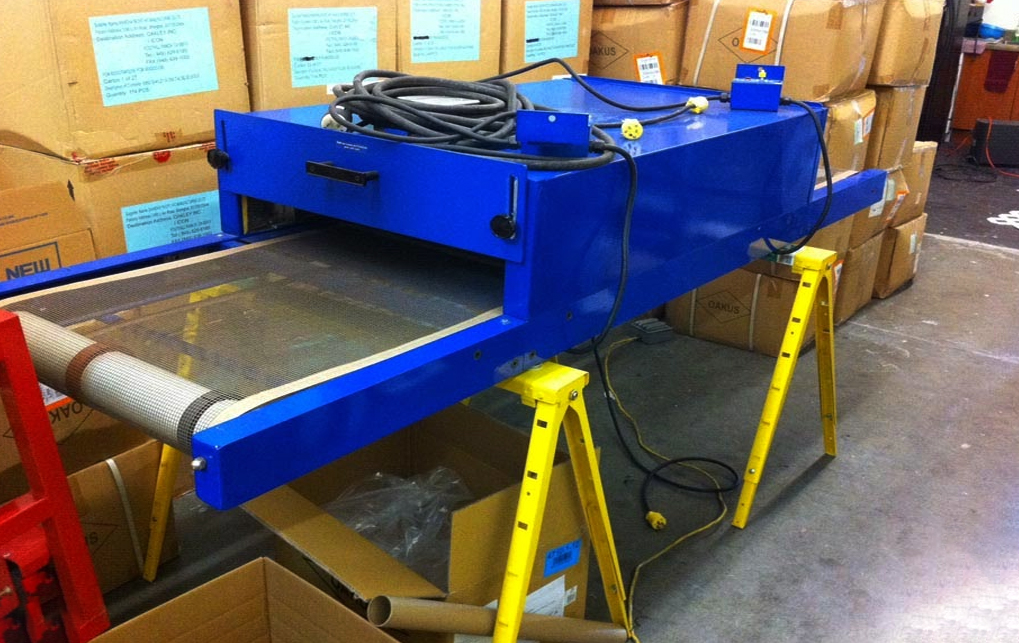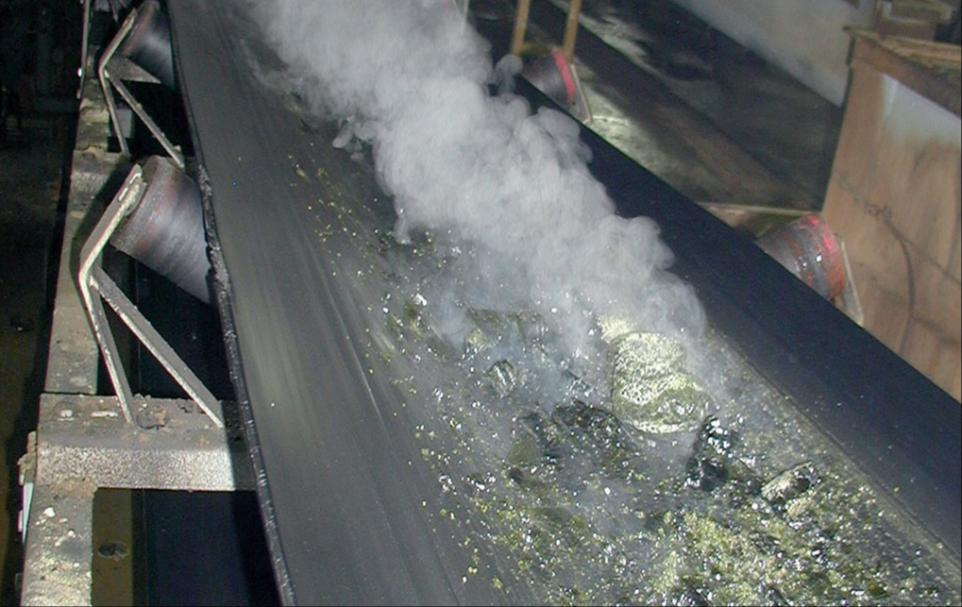Transporting materials and working environments that are too hot can easily damage the conveyor belt. To prevent possible damage, different types of heat-resistant conveyor belts are used corresponding to different temperature conditions. Under normal circumstances, a normal conveyor belt operates perfectly at temperatures up to 80°C. Higher temperatures can cause serious damage and reduce the life of the belt increasing repair and replacement costs. position. Heat-resistant conveyors choose heat-resistant compounds and innovative structures to solve these problems.
What is heat-resistant conveyor belt?
Heat-resistant conveyor belts are a type of conveyor belt designed to operate in environments with higher temperatures than conventional conveyors. Heat-resistant conveyors manufactured to standards can transport materials up to 400°C at a constant temperature of 200°C. The heat resistance of a conveyor belt depends on the type of material used for production. Different materials have different heat resistances and therefore respond to different maximum temperatures.
Heat-resistant conveyor belts are a necessary component for use in high-temperature situations, such as those found in the steelmaking, mining and cement manufacturing sectors, as well as the electricity production sector. Heat-resistant conveyors have undergone extensive testing to ensure that they can withstand very high temperatures, maintain effective levels of material movement, protect personnel from injury and keep equipment safe. expensive works well.
Features of heat-resistant conveyor belts
Important technical features of heat-resistant conveyor belts include:
Heat resistance. This is the most important feature of heat-resistant conveyor belts. The heat resistance of the conveyor belt must meet the requirements of the specific application. Normally, heat-resistant conveyor belts are capable of withstanding temperatures from 150 degrees Celsius to 400 degrees Celsius.
Durability: Heat-resistant conveyor belts must have high durability to withstand pressure and impact during operation.
Abrasion resistance: Heat-resistant loads must be abrasion resistant to ensure the longevity of the conveyor belt.
Tensile strength: Heat-resistant conveyor belts must have high tensile strength to avoid breakage and minimize problems related to belt breakage. Oil and chemical resistance Heat-resistant conveyors are often used in environments with heads and substances chemical, so the oil and chemical resistance of the conveyor belt is also an important feature.
Structure and dimensions: Heat-resistant conveyor belts must be designed with appropriate structures and dimensions to meet the requirements of the specific application. These characteristics must be chosen so that the conveyor can move items effectively and safely.
Durability to environmental conditions. Environmental conditions such as humidity, UV rays and other factors can also affect the durability of heat-resistant conveyor belts, so it is necessary to consider the durability of the conveyor belt under specific environmental conditions.

Types of plastic chains are commonly used today
Below are the popular types of heat-resistant conveyor belts today:
1 - Heat-resistant mesh conveyor belt
Heat-resistant mesh conveyor belts are usually stainless steel mesh conveyors or conveyor belts that use lazy belts made of stainless steel alloy with high heat resistance. Specifically, heat-resistant mesh conveyor belts can withstand temperatures up to about 600 degrees Celsius. However, the heat resistance of heat-resistant mesh conveyor belts also depends on other factors such as application environment and speed. conveyor movement, pressure, humidity and exposure to high temperatures. Therefore, to ensure the performance and longevity of heat-resistant mesh conveyors, you should follow the manufacturer's instructions for use and perform periodic maintenance measures to minimize the effects of high temperatures. onto the conveyor belt.
* Application of heat-resistant mesh conveyor belt
Heat-resistant mesh conveyor belt is a type of conveyor belt used to transport materials at high temperatures. Heat-resistant mesh conveyors are also used to transport various materials, such as limestone, fly ash and cement. Heat-resistant mesh conveyors are also used in power plants to transport coal and other materials from storage to incinerators. In addition, heat-resistant mesh conveyor belts are also used in the food industry to bake bread and produce other products.
 Heat-resistant mesh conveyor belt can withstand heat up to 400 degrees Celsius
Heat-resistant mesh conveyor belt can withstand heat up to 400 degrees Celsius
2 - Heat-resistant rubber conveyor belt
Heat-resistant rubber conveyor belt is a type of conveyor belt made from heat-resistant rubber, capable of withstanding high temperatures and other harsh conditions. Using heat-resistant rubber conveyor belts can bring many benefits such as long life, good durability, and minimizing damage to materials during movement.
* Applications of heat-resistant rubber conveyor belts:
Heat-resistant rubber conveyor belts are widely used in industries producing heat-resistant materials, including metallurgical industries, cement, coal, clinker, glass, ceramics, etc. Used to transport heat-resistant materials such as coal, cement...
 Highly efficient heat-resistant rubber conveyor belts in the mining industry
Highly efficient heat-resistant rubber conveyor belts in the mining industry
Heat-resistant drying conveyors are an effective solution for drying heat-resistant materials in other manufacturing processes together. This device uses heat to remove moisture from these materials through heat transfer and evaporation. It can be adjusted to dry materials with different moisture content and sizes, and is integrated with control devices to ensure the drying process takes place efficiently and safely. Thermal drying conveyor belts are highly durable and can withstand high temperatures while maintaining flexibility.
* Applications of heat-resistant drying conveyor belts:
Heat-resistant drying conveyor belt is a type of conveyor belt designed for use in the drying and drying processes of heat-resistant materials such as ore, coal, cement, metal powder, etc. Thermal drying conveyor belt is used in production process for drying materials such as plastic granules, flour, animal feed, rice, sugar and other industrial products.
 Thermal drying conveyor effectively dries food
Thermal drying conveyor effectively dries food
Things to note about heat-resistant conveyor belts
Heat is essential for chemical heating, thermal product purification, food processing plants, metal forming plants and many other industries. Many corporations use heat-resistant conveyors to move burning coal or plain coal from one place to another. Some things you need to know to know how to choose the right conveyor belt for your company.
- Reliability
It is a factor that you need to pay attention to before choosing your ideal conveyor belt. Conveyor belts need to be durable because durable belts will last longer and will not deform when loads of burning coals are placed on them. A reliable belt will also last longer so your maintenance is less expensive. The belt will not stretch even at high temperatures.
- Limit moisture absorption
Moisture on the belt will be limited, helping you protect yourself when working and the belt will have a very low chance of burning.
- Heat sensitivity
The right belt will have a heat sensitivity of about 700 degrees F which will keep the belt in the safe zone. Always make sure you choose a belt with a similar heat sensitivity to this.
How much does heat-resistant conveyor belt cost?
The price of heat-resistant conveyor belts can vary depending on factors such as manufacturing materials, size, thickness, durability, heat resistance, brand, etc. In many cases, the price of the belt Heat-resistant loads can be higher than conventional conveyors because they must use special materials and manufacturing technology to ensure heat resistance and durability in high-temperature environments.
Prices for heat-resistant conveyor belts range from 200,000,000 to billions of VND depending on the type of conveyor belt. However, the price of heat-resistant conveyor belts can be offset by greater performance and longevity during operation. When choosing a heat-resistant conveyor belt, all factors should be considered to ensure the correct value and performance of the product. Advances in heat-resistant conveyors help improve efficiency and safety.
Conveyors that can withstand high temperatures have seen significant improvements in efficiency and safety thanks to recent technological developments. This has resulted in increased production and reduced downtime. The most recent developments in heat-resistant conveyor belts focus on how these belts improve both productivity and safety in high-pressure industrial environments.
Advances in heat-resistant tape help improve efficiency and safety
Conveyors that can withstand high temperatures have made significant improvements in efficiency and safety thanks to recent industrial developments. This has resulted in increased production and reduced downtime. The most recent developments in heat-resistant conveyor belts focus on how these belts improve both productivity and safety in high-pressure industrial environments.
- Improves heat resistance
he ability of conveyor belts to withstand high temperatures has been greatly enhanced by the development of innovative heat-resistant materials such as synthetic rubber, polymers and thermoplastic composites. These materials can withstand higher temperatures without deterioration or loss of mechanical quality, which ensures that they have a longer service life.
Even in areas with extreme temperatures, modern conveyor belts feature reinforcement layers for added support and strength. The ocean's resistance to heat-induced stretching and tearing is increased by innovative reinforcing materials such as aramid fibers and steel wire, which also contribute to its durability and reliability.
Enhanced fire protection
Load panels designed to withstand high temperatures now have fire retardant chemicals and coatings incorporated into their construction. These properties prevent the spread of fire. These specialized straps have reduced flammability as well as features that allow them to self-extinguish in the event of a fire. As a result, the risk of a fire-related incident is significantly reduced and worker safety is maximized.
Conveyor systems can be equipped with highly developed fire detection and suppression systems that can identify and extinguish fires in a short period of time. These systems use cutting-edge technology such as infrared sensors, flame detectors, and automatic water or foam-based fire suppression systems. As a result, they reduce the risk of fire and avoid catastrophic damage.
- Improve efficiency in operations
Thanks to advances in belt covering materials and manufacturing processes, heat resistance has increased significantly and energy consumption has decreased significantly. Conveyor belts that are heat resistant and have low friction coatings not only help increase the overall efficiency of the system but also reduce the amount of energy lost, helping to save costs for businesses.
The design of modern heat resistant conveyors focuses on maximizing material flow while minimizing spillage. Conveyor systems often have butts, sidewalls, and other specialized features to facilitate efficient material handling, thereby reducing the possibility of jams and increasing their overall productivity.
- Features designed to enhance safety
The integrated thermal monitoring system makes it possible to monitor temperature throughout the length of the conveyor belt in real time. These systems use sensors to detect unusually high levels of heat and notify the operator when this occurs. This gives the operator the opportunity to act early and reduces the risk of belt failure or equipment damage.
Modern belt tracking and alignment systems ensure that the conveyor belt is always accurately aligned, thereby reducing the likelihood of belt misalignment and the severity of any accidents that may occur. These systems use sensors and automatic controls to change the position of the belt and ensure that it always tracks accurately.






